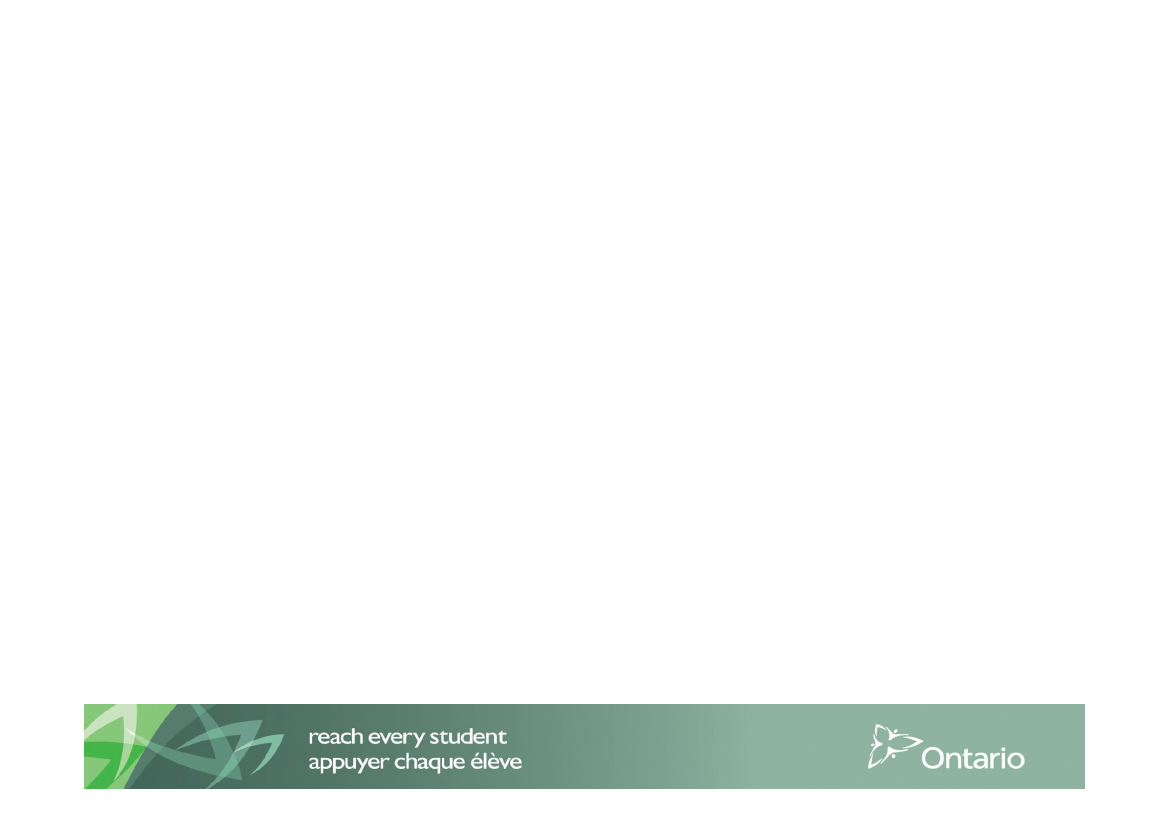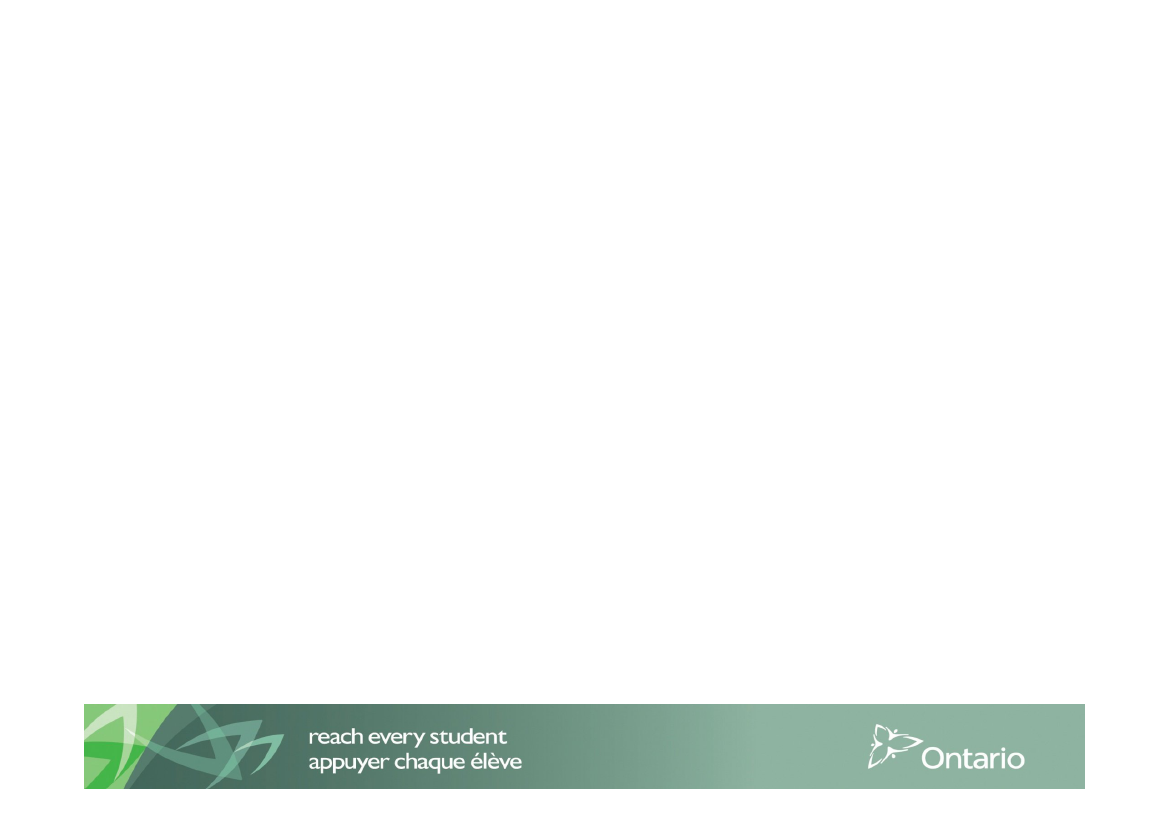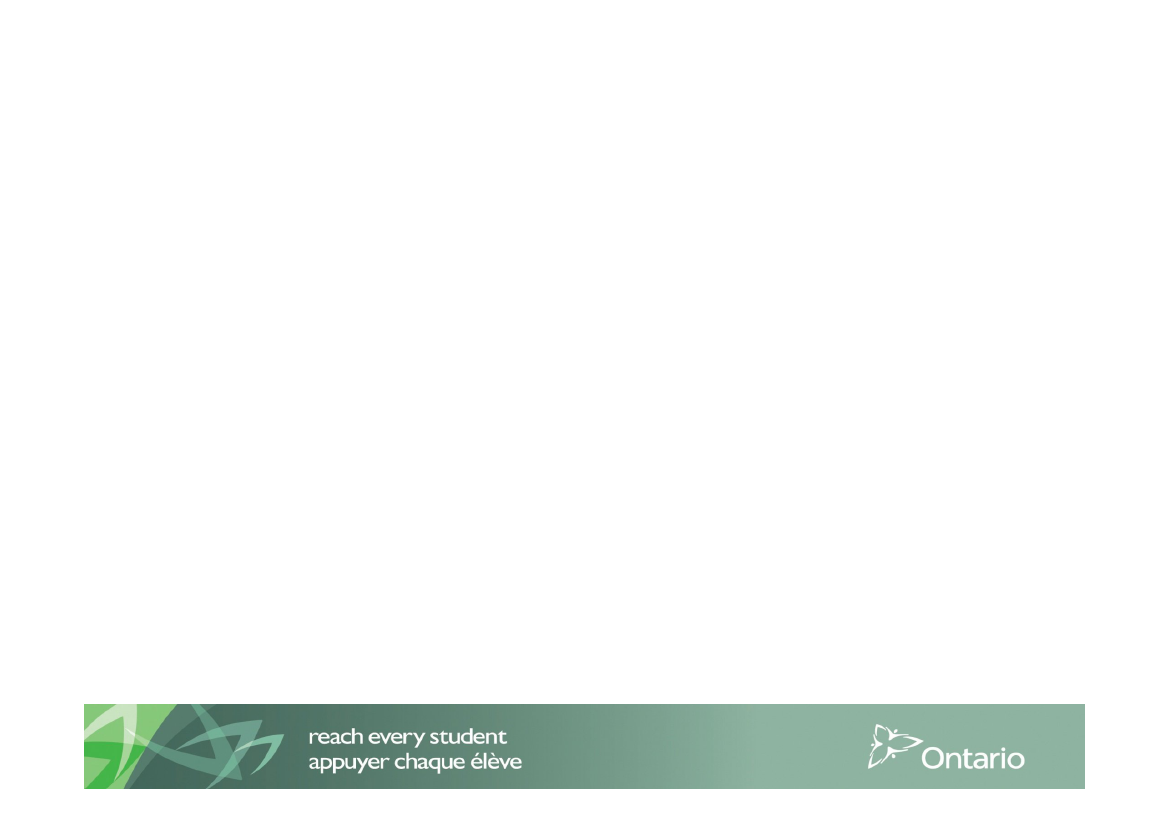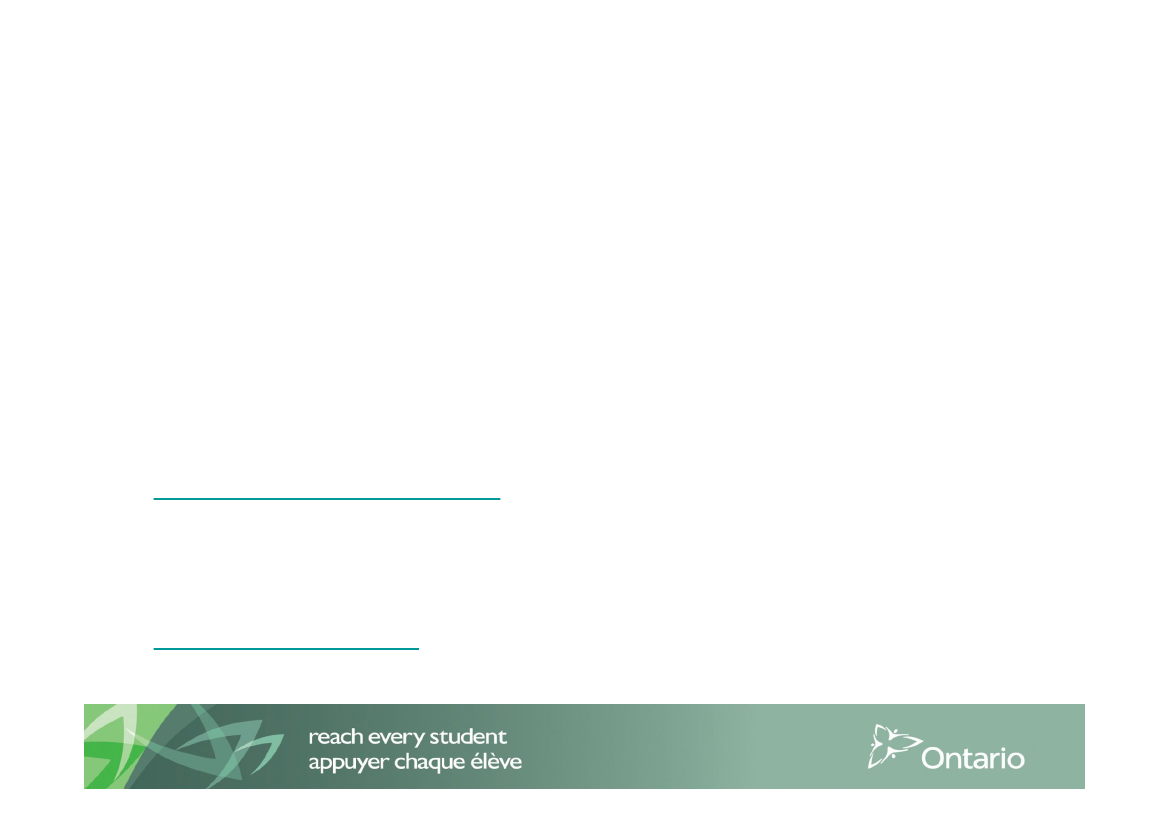Børne- og Undervisningsudvalget 2011-12
BUU Alm.del Bilag 265
Offentligt
Ontario Education Improvement“We are improving each year.People are getting smarter.We are starting to think school has potential!”-Ontario elementary student 2010
Mary Jean GallagherChief Student Achievement Officer of OntarioAssistant Deputy MinisterStudent Achievement DivisionMinistry of Education1
Snapshot – Province of OntarioOntario has:• 40% of Canada’s 33.6 million people (itisthe mostpopulous province)• 60% of 225,000 immigrants who come to Canadaannually• Over 1 million square kilometres of land• 2.1 million students, 27% born outside Canada• Almost 126,000 teachers (unionized teaching andsupport staff)• About 5,000 schools in 72 school districts• Funding of $20.2B (CDN) in 2010-11 (40% increasecompared to 2002-03)
2
Curriculum, Standards & Assessment••The right policies are enabling scaffolds to a “smart” systemCommon Curriculum Documents–––By grade K – 6, by subject 7 – 12Developed and published by the Ontario GovernmentOntario: a “cool” curriculum vs. “hot”
•
Standards of Performance–Established by the Ontario Government
•
Assessment of Performance––Largely teacher/classroom developed and basedFormalized Province wide assessment•••••••Independently developed and marked – EQAOStandards basedBased on the Ontario curriculumReading, writing and mathematics, Grades 3&6Academic and applied math, grade 9Literacy, grade 10 (graduation requirement)Transparency of results
•
Pedagogy–A highly qualified and capable, engaged and empowered profession3
Signs ofsuccess
4
Overall Elementary Achievement Growth:2002-03 to 2011-1275%70%67%69%70%
68%
65%62%
64%
65%63%
60%55%50%54%
58%
2002-03
2003-04
2004-05
2005-06
2006-07
2007-08
2008-09
2009-10
2010-11
2011-12
6
Ontario’s International Standing•Programme for International Student Assessment (PISA) 2009– From 65 countries, only Shanghai, China scored significantly better in reading. Inmathematics Ontario scored very well.– In Ontario, the difference in achievement between students in the top socio-economicquarter and the lowest quarter was half the OECD average.– Within Canada, Ontario has the highest proportion of immigrant students.
••••
McKinsey Report 2009: How the World’s Most Improved School SystemsKeep Getting BetterOntario: sustained improvement, from 2003-2009 moved from “good” to“great”, now moving from “great” to “excellent”Pan Canadian Assessment Program 2010Ontario is the only province above the Canadian average in reading, mathand science7
Lessons from Ontario•Ontario’s approach to critical thinking and creativity… [is] woven intovirtually all aspects of schooling– across the curriculum– use of formative assessments
•
Ontario’s curriculum, assessment and reporting have moved from anemphasis on mastery of facts to an understanding of “big ideas” andthe ability to apply one’s knowledge to the problems one confronts ineveryday lifeInterdisciplinary approaches, systems thinking, and collaborativeinquiry into problems of practice is increasingly the norm in Ontarioschools, strongly supported by the work of the Literacy andNumeracy Secretariat, the Student Success/Learning to 18 team,and other units in the ministry.From OECD Report: Strong Performers and Successful Reformers in Education: Lessons from PISAfor Japan - 20118
•
Lessons from OntarioOntario’s strong PISA results would suggest that this emphasis onbuilding the critical thinking and problem-solving skills of teachers hasstrengthened the capacity of teachers to enable the development ofthese same kinds of skills in their studentsOntario has created a broad set of enabling conditions, including:– comprehensive early learning and childcare system– strong cultural commitment to the importance of education
From OECD Report: Strong Performers and Successful Reformers in Education: Lessonsfrom PISA for Japan - 2011
9
How we’vedone it
10
Implementation and Focus1. A small number of ambitious goals– High levels of student achievement• 75% of students with high level of literacy andnumeracy skill by age 12• 85% of students graduating from high school within5 years of starting
– Reduced gaps in student achievement– Increased public confidence in education11
Implementation and Focus2. A Guiding Coalition at the Top– Premier– Minister of Education– Deputy Minister– Chief Student Achievement Officer
12
Implementation and Focus3. High Standards and Expectations– A standards based curriculum– A transparent standard of performance– Independent assessments of studentachievement– Provincial standards of literacy and numeracyrequire creative thinking, problem solving,higher order thinking skills13
Implementation and Focus4. Investment in leadership and capacitybuilding related to instruction
14
Implementation and Focus4. Investment in leadership and capacitybuilding related to instructionStudent Supports–Full Day Kindergarten–Tutoring–Interventions:12&12+ Re-engagement, creditrescue, credit recovery–More Relevant Programs: SHSM, Dual Credit,Differentiated Instruction–Student Voice
15
Implementation and Focus• Apprenticeship and training– Provided within the Ministry of Training,Colleges and Universities– Combination of work placement hours,college programs, and certifications– Many secondary schools offer programsaligned with apprenticeship preparation
16
Implementation and FocusSpecialist High Skills Majors (SHSM)2006-07Year 1600 students in27 programs in44 schools
2007-08Year 26000 students in153 programs in212 schools
2008-09Year 314,000 students inover 480 programsin 335 schools
2009-10Year 420,000 students inover 740 programsin 430 schools
2010-11Year 528,000 students inover 1000programs in 540schools
2011-12Year 634,000 studentsin over 1300programs in over630 schools
2012-13Year 738,000 studentsin over 1,500programs670 schools
Sectors:Arts and CultureConstructionHospitalityTourismManufacturingAgricultureForestryHorticulture &LandscapingMining
Addition of:BusinessEnvironmentHealth & WellnessTransportation
Addition of:
Addition of:
Addition of:SportsNon-profit
No newsectors
InformationEnergyCommunicationAviation andTechnologyAerospaceJustice, CommunitySafety andEmergencyServices
Possible FoodProcessing –tobe confirmed
17
Implementation and Focus4. Investment in leadership and capacity buildingrelated to instructionClassroom Supports•
Funding for:•Professional LearningCommunities•Collaboration
•
Professional Resources•Growing Success•Learning for All•Differentiated Instruction•Math and Literacy Gains•Guides to EffectiveInstruction•DVDs and Monographs18
••••
Staff to Support ChangesStudent Work Study TeachersCollaborative Inquiry for Learningin MathematicsShared Research and Evidence
Implementation and Focus4. Investment in leadership and capacity buildingrelated to instructionSchool Supports•
School Effectiveness Framework – a staff engagement tool
19
Implementation and Focus4. Investment in leadership and capacity buildingrelated to instructionSchool Supports -School Improvement ProgramsSmart GoalsNeedsAssessment•••••Studentachievement dataDemographic dataProgram dataPerceptual dataAnalysis of data
Targeted, EvidenceBased StrategiesResources
ProfessionalLearningMonitoringResponsibility20
Evaluation
Implementation and Focus4. Investment in leadership and capacity buildingrelated to instructionLeadership Supports•School Effectiveness Leaders•Student Success Leaders•Student Achievement Officers•Secondary School Education Officers•Ontario Leadership Strategy•Improvement Planning Processes21
Implementation and Focus5.Mobilizing data and effective practices as a strategyfor improvementProvincial Results for Junior Writing(English-Language)908070
• Building a data system– Assessments– Tracking dataPercent at Levels 3&4
605040302010
2002-03All54Girls64Boys44SpecEd12ESL/ELL 24
0
2003-045464451127
2004-055968501434
2005-066172511739
2006-076172501742
2007-086776582853
2008-096778572855
2009-107079613158
2010-117382643661
2011-127483674063
22
Implementation and Focus5.Mobilizing data and effective practices as a strategyfor improvement
Implementation and Focus• Mobilizing data and effective practices asa strategy for improvement– Building an evidence based culture– Precise teaching to meet student needs– Teaching Learning Critical Pathway– School Improvement Planning24
K-12 Math Strategy• Broaden The Strategy By Implicating MorePeople In Improving MathematicsAchievement– More systematically engaging parents– Making numeracy an explicit focus– Emphasizing role of school and systemleadership
K-12 Math Strategy• Deepen the strategy– Continue to building on effective professionallearning – Paying Attention to Mathematics– Continue to address needs of students inapplied courses– Differentiated support for DSBs
K-12 Math Strategy• Building a Foundation for SustainableImprovement– Comprehensive plan for curriculum review– Reviewing uptake of Ministry resources– Deepening understanding of mathematics learning in theearly years– Leveraging changes to teacher pre-service education– Focusing more summer learning programs on numeracy
Implementation and Focus6.Intervention in a Non Punitive Manner• Ontario Focused Intervention Program (OFIP)• Student Success School Support Initiative (SSI)
OFIP
SSI
28
Implementation and Focus7.Supporting Conditions and Reducing Distractions• Full day Kindergarten• Negotiations and collectiveagreements• Ontario Leadership Strategy• Governance Legislation• Research Strategy• Equity Policy and Initiatives• Aboriginal Education Unit• Character Education• Safe Schools & Anti Bullying• Healthy Schools• Community Use of Schools• Anti Poverty Agenda• Mental Health Strategy
29
Implementation and Focus8.Being transparent, relentless and increasinglychallenging•••All children can learnA sense of urgencySustaining and extending our reforms
30
Key Elements - Literacy and NumeracyCLASSROOM TEACHING ANDLEARNINGTutors in the ClassroomOFIP TutoringStudent Work Study TeachersCollaborative Inquiry for Teaching inMathematicsSmall and Northern BoardsNumeracyKindergarten and Grade 1Collaborative InquiryEarly Literacy InitiativesGuides to Effective InstructionProfessional DVDs and MonographsMath for Young ChildrenJunior Math Initiative
SCHOOL EFFECTIVENESSSchool Effectiveness FrameworkSchool Improvement PlanningOFIP Low Performing SchoolsSchools in the MiddleSchools Helping SchoolsNetworkingLEADERSHIPSchool Effectiveness LeadsStudent Achievement OfficersConnections to Other MinistryBranches and Work (OntarioLeadership Framework, Learningfor All, Growing Success)31
Key Elements of Student SuccessPROGRAMSSpecialist High Skills MajorDual CreditsExpanded Cooperative EducationBoard Specific Programs, e.g.,transition planning, alternative ed;adult & continuing ed.Student Voice
INTERVENTIONSCredit Rescue and RecoveryTransitions/Taking StockCaring AdultChildren and Youth in Care
12/12+ Re-engagement Strategy
Supervised Alternative LearningCULTURE AND LEADERSHIPStudent Success Leaders, StudentSuccess Teachers and StudentSuccess TeamsSecondary School EducationOfficersSchool Support Initiative32Board Improvement Plans
INSTRUCTIONDifferentiated InstructionMath & Literacy GAINSSchool Effectiveness Framework
Thank you!For Further Information please contact:Mary Jean Gallagher1-416-325-9964[email protected]Or Contact Executive Assistant:Kim Spence1-416-327-5317[email protected]

































